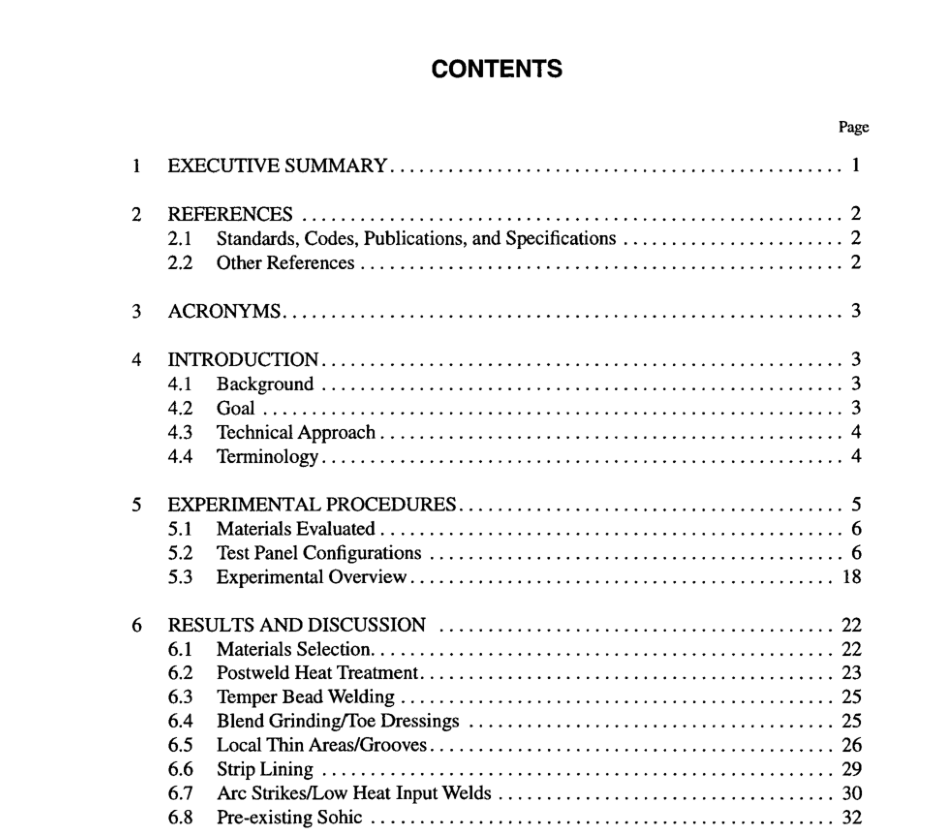API PUBL 939-B pdf download

API PUBL 939-B pdf download.Repair and Remediation Strategies for Equipment Operating in Wet H2S Service
1 Executive Summary
This report summarizes the experimental methods and findings of a research project titled Repair and Remediation Strategies for Equipment Operating in Wet H2S Service con- ducted by the Materials Properties Council, Inc. (MPC). The project was jointly funded by MPC and the M I Committee on Refinery Equipment. The overall goal was to provide guidelines for effective repair procedures for use in remediation of equipment dam- aged in wet H2S service and to minimize the reoccurrence of cracking after inspection and/or repair. These included spe- cific aspects related to: a. The use of temper bead as opposed to conventional weld repairs. b. The postweld heat treatment (PWHT) versus as-welded. c. Local thin areas in the base metal and grooves in the heat- affected zone (HAZ) which result from removal of cracks found by inspection. d. Influence of blend grinding on internal fillet-welded attachments. e. Evaluation of surface treatments. f. Serviceability of pre-existing wet H2S damage. To accomplish these goals, a series of large-scale exposure tests were conducted with steel test panels, containing various repair and remediation variables, welded into the body of a large-scale fabricated steel vessel filled with a pressurized H2S containing solution prepared in accordance with NACE Standard Th40177, Solution A. Experiments were performed using test panels comprised of conventional, low sulfur con- ventional, hydrogen-induced cracking (HIC) resistant and advanced thermo-mechanically controlled processed steelsper the ASTM A 516-70, A 285-C and A 841 specifications. One of the most significant findings of the project was the impact of PWHT on reducing the number of toe cracks on both full penetration and attachment welds. It was demon- strated that the impact of PWHT was the result of: 1. The reduction in hardness observed in the weld area. 2. The reduction in the tensile residual stresses in the weldment. These findings were supported by two series of experi- ments. One of the experiments compared the performance of as-welded versus PWHT attachments. A large number of toe cracks were produced on the as-welded attachments to conventional and low-sulfur conventional A 516-70 and no toe cracks were observed on the PWHT attachments. The difference in performance related most heavily to the range in hardness between the two techniques. In another experiment, as-welded and PWHT full penetration welds were fabricated in one of the test panels. Both the as-welded and PWHT full penetration welds possessed low hardnesses with respect to sulfide stress cracking (SSC) susceptibility; however, the as-welded, full penetration weldments still produced toe cracks despite the low hard- ness levels. Hence, the benefit of PWHT in this case most likely related to the reduction in tensile residual stress across the weldments combined with the reduced hardness as a result of PWHT. Another important finding was the similarity in perfor- mance between conventional weld repairs with PWHT and temper bead weld repairs without PWHT. If repair welds are to be PWHT, then the weld repair would be made using a conventional procedure; however, if the repair welds are not to be subjected to a PWHT then the use of a temper bead technique might be chosen. In this project, the number of cracks observed in the weld area between the two procedures was nearly equivalent. Comparison of the total crack thick- ness in the weld area for both techniques also revealed consis- tency in behavior between the two techniques. No benefit was derived from the use of blend grinding. In general, blend ground fillet attachment welds produced a greater number of toe cracks than non-treated fillet attach- ments. Deep toe dressings were also evaluated at fillet attach- ments and along full penetration welds. These results also indicated no benefit. In several instances on the low sulfur conventional A 5 16-70 steel, stress-oriented hydrogen- induced cracking (SOHIC) was found to initiate at the bottom of the deep toe dressings and propagate into the base plate to varying depths.









